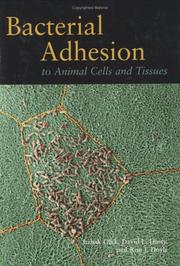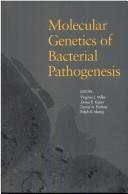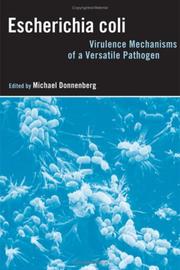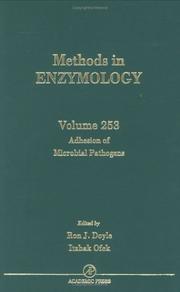| Listing 1 - 10 of 16 | << page >> |
Sort by
|
Dissertation
Year: 1997 Publisher: Leiden Sinteur
Abstract | Keywords | Export | Availability | Bookmark
 Loading...
Loading...Choose an application
- Reference Manager
- EndNote
- RefWorks (Direct export to RefWorks)
Yersinia enterocolitica --- Adhesins, Bacterial --- Granulocytes --- immunology
Dissertation
Abstract | Keywords | Export | Availability | Bookmark
 Loading...
Loading...Choose an application
- Reference Manager
- EndNote
- RefWorks (Direct export to RefWorks)
Bacterial Adhesion --- Bordetella pertussis --- Bronchi --- Adhesins, Bacterial --- pathogenicity --- microbiology --- immunology
Dissertation
ISBN: 9782930404370 Year: 2007 Publisher: Liège : Presses de la Faculté de Médecine vétérinaire de l'Université de Liège,
Abstract | Keywords | Export | Availability | Bookmark
 Loading...
Loading...Choose an application
- Reference Manager
- EndNote
- RefWorks (Direct export to RefWorks)
Escherichia coli --- O antigens --- Cattle --- Lipopolysaccharides --- Adhesins, escherichia coli --- Antibodies, monoclonal --- Immunology --- Microbiology --- Genetics

ISBN: 1555812635 Year: 2003 Publisher: Washington : ASM Press,
Abstract | Keywords | Export | Availability | Bookmark
 Loading...
Loading...Choose an application
- Reference Manager
- EndNote
- RefWorks (Direct export to RefWorks)
Cellule --- cells --- Tissu animal --- Animal tissues --- Bacteria --- Agent pathogène --- Pathogens --- Adsorption --- Infection --- Pouvoir pathogène --- Pathogenicity --- Cell adhesion molecules. --- Bacterial Adhesion. --- Adhesins, Bacterial. --- Adhesion. --- Adhesins, bacterial --- Bacterial adhesion --- Bacterial physiology
Periodical
Abstract | Keywords | Export | Availability | Bookmark
 Loading...
Loading...Choose an application
- Reference Manager
- EndNote
- RefWorks (Direct export to RefWorks)
biomaterials --- microbiology --- biofilms --- multicellular communities --- microbial cells --- bioengineering --- Biofilms --- Biofilms. --- Microbial aggregation --- Microbial ecology --- Biofilm --- Dental Deposits --- Prosthesis-Related Infections --- Adhesins, Bacterial --- Biofouling
Book
ISBN: 9782889195572 Year: 2015 Publisher: Frontiers Media SA
Abstract | Keywords | Export | Availability | Bookmark
 Loading...
Loading...Choose an application
- Reference Manager
- EndNote
- RefWorks (Direct export to RefWorks)
The interplay between host and pathogen is a complex co-evolutionary battle of surveillance and evasion. The pathogen continuously develops mechanisms to subvert the immune response in order to establish infection while the immune system responds with novel mechanisms of detection. Because the majority of Lyme disease pathology is due to an over-exuberant immune response, much research in Borrelia burgdorferi pathogenesis has been devoted to understanding the mammalian host response to the bacterium. Immunological studies continue to be an active area of research employing emerging techniques, such as intra-vital imaging. These studies have furthered our understanding of inflammatory processes during long-term infection and provided some surprising insights, such as the continued presence of bacterial products after clearance. The field of Lyme disease has long debated the etiology of long-term inflammation and recent studies in the murine host have shed light on relevant cell types and inflammatory mediators that participate in the pathology of Lyme arthritis. Live imaging and bioluminescent studies have allowed for a novel view of the bacterial life cycle, including the tick mid-gut, tick-to-mammal transmission and dissemination throughout a mouse. A number of tick and bacterial proteins have been shown to participate in the completion of the enzootic cycle. Novel mechanisms of gene regulation are continuously being identified. However, B. burgdorferi lacks many traditional virulence factors, such as toxins or specialized secretion systems. Many genes in the B. burgdorferi genome have no known homolog in other bacteria. Therefore, studies focusing on host-pathogen interactions have therefore been limited by an incomplete understanding of the repertoire of bacterial virulence factors. Questions such as how the pathogen causes disease, colonizes the tick and evades host immune-surveillance have been difficult to address. Genetic studies involving single gene deletions have identified a number of important bacterial proteins, but a large-scale genomics approach to identify virulence factors has not been attempted until recently. The generation of a site-directed mutagenesis library is an important step towards a detailed analysis of the B. burgdorferi genome and pathogenome. Using this library, high-throughput genomic studies, utilizing techniques such as massively parallel sequencing have been promising and could be used to identify novel virulence determinants of disease in the mammalian host or persistence in the tick vector. Continued research on this unique pathogen and its specific interaction with host and vector may have far reaching consequences and provide insights for diverse disciplines including ecology, infectious disease, and immunology. Here, several reviews will discuss the most recent advances and future studies to be undertaken in the field of B. burgdorferi biology.
Infectious Diseases --- Medicine --- Health & Biological Sciences --- Borrelia burgdorferi --- innate immunity --- adhesins --- Tnseq --- Eicosanoids --- Lyme Disease --- TLR --- c di GMP --- Ixodes scapularis --- Lyme Arthritis

ISBN: 1555810829 Year: 1994 Publisher: Washington, DC : ASM [American Society for Microbiology],
Abstract | Keywords | Export | Availability | Bookmark
 Loading...
Loading...Choose an application
- Reference Manager
- EndNote
- RefWorks (Direct export to RefWorks)
Bacteria --- Gene Expression Regulation, Bacterial --- Virulence --- Bacterial diseases --- Pathology, Molecular --- Virulence (Microbiology) --- Pathologie moléculaire --- Virulence (Microbiologie) --- pathogenicity --- genetics --- Pathogenesis --- Pathology, Molecular. --- Pathogenesis. --- Virulence (Microbiology). --- Pathologie moléculaire --- Gene Expression Regulation, Bacterial. --- pathogenicity. --- genetics. --- Genetics. --- Adhesins --- Transduction, genetic --- Virus, bacterial

ISBN: 0122207513 9786611011598 1281011592 0080494811 9780122207518 9781429483070 1429483075 9780080494814 9781281011596 Year: 2002 Publisher: Amsterdam, Boston : Academic Press,
Abstract | Keywords | Export | Availability | Bookmark
 Loading...
Loading...Choose an application
- Reference Manager
- EndNote
- RefWorks (Direct export to RefWorks)
DescriptionAlthough most strains of E. coli bacteria are harmless and live in the intestines of healthy humans and animals, several strains can produce powerful toxins and cause severe illness in humans. This versatile pathogen is best known for being transmitted to humans through contaminated foods - such as undercooked meat and unpasteurized fruit juice - and has attracts much attention when serious outbreaks occur.Importance of TopicE. coli is capable of causing a wide variety of diseases - from urinary tract infections to meningitis. A considerable amount of m
Escherichia coli infections. --- Escherichia coli. --- Virulence (Microbiology) --- Microbial virulence --- Pathogenic microorganisms --- E. coli (Bacterium) --- Escherichia --- Colibacillosis --- Gram-negative bacterial infections --- ESCHERICHIA COLI --- ADHESINS, ESCHERICHIA COLI --- ANTIGENS, BACTERIAL --- SHIGA TOXINS --- HEMOLYSINS --- GENETICS --- PATHOGENICITY --- ULTRASTRUCTURE --- CLASSIFICATION

ISBN: 0121821544 9780121821548 Year: 1995 Volume: 253 Publisher: San Diego: Academic press,
Abstract | Keywords | Export | Availability | Bookmark
 Loading...
Loading...Choose an application
- Reference Manager
- EndNote
- RefWorks (Direct export to RefWorks)
Enzymology --- Adhesion cellulaire --- Celadhesie --- Cell adhesion --- Cellen--Pathogene micro-organismen --- Cellules--Micro-organismes --- Intracellular pathogenic micro-organisms --- Intracellular pathogens --- Intracellulare pathogene micro-organismen --- Micro-organismen [Intracellulare pathogene ] --- Micro-organismes pathogenes dans la cellule --- Micro-organismes pathogenes intracellulaires --- Pathogene micro-organismen in de cel --- Bacteries --- Adhesines --- Micro-organismes --- Micro-organismes pathogenes --- Adhesivite. --- Adhesivite --- Microorganisms. --- Bacteries - Adhesivite. --- Bacteries - Adhesivite --- Micro-organismes - Adhesivite --- Adhesins
Periodical

ISSN: 20555008 Year: 2015 Publisher: [New York, NY ?] Nature Publishing Group
Abstract | Keywords | Export | Availability | Bookmark
 Loading...
Loading...Choose an application
- Reference Manager
- EndNote
- RefWorks (Direct export to RefWorks)
Biofilms --- Microbiology --- Microorganisms --- Microbial ecology --- Biofilms. --- Microbiological Phenomena. --- Microbial ecology. --- Microbiology. --- Microorganisms. --- Germs --- Micro-organisms --- Microbes --- Microscopic organisms --- Organisms --- Microbial biology --- Biology --- Environmental microbiology --- Ecology --- Microbial aggregation --- Microbial Concepts --- Microbial Phenomena --- Microbiologic Concepts --- Microbiological Phenomenon --- Microbiological Process --- Phenomena, Microbiologic --- Microbiologic Phenomena --- Microbiological Processes --- Concept, Microbial --- Concept, Microbiologic --- Concepts, Microbial --- Concepts, Microbiologic --- Microbial Concept --- Microbiologic Concept --- Phenomena, Microbial --- Phenomena, Microbiological --- Phenomenon, Microbiological --- Process, Microbiological --- Processes, Microbiological --- Dysbiosis --- Biofilm --- Dental Deposits --- Prosthesis-Related Infections --- Adhesins, Bacterial --- Biofouling --- biofilms --- microbiomes --- viromes --- phageomes --- mycomes --- fungomes --- General microbiology --- General ecology and biosociology
| Listing 1 - 10 of 16 | << page >> |
Sort by
|

 Search
Search Feedback
Feedback About UniCat
About UniCat  Help
Help News
News